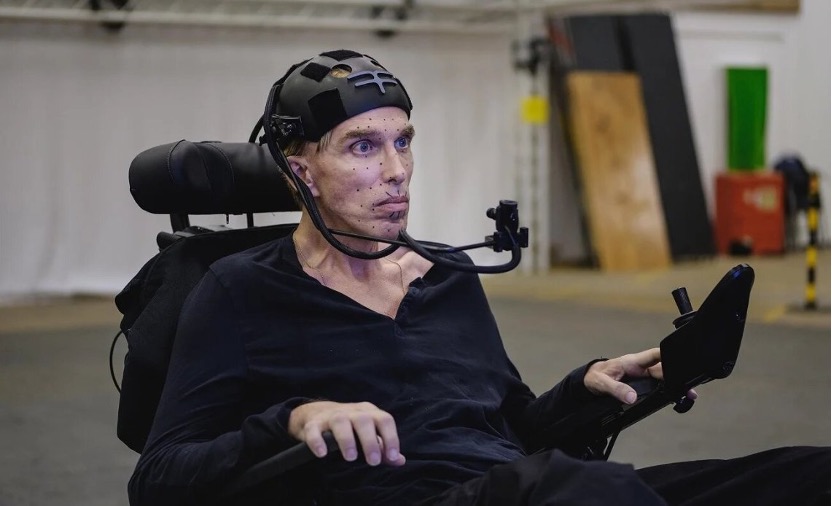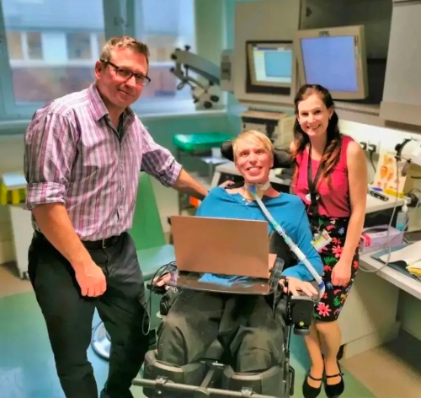
"If (humans) choose to go down the path of 'enhancing people', then it is possible for humans and robots to follow the same evolutionary path...so that human beings will one day be able to replace their too fragile bodies with more permanent mechanisms, And use supercomputers as smart amplifiers," Peter Scott-Morgan wrote in Robot Revolution, published in 1984.

 Cyborg is a combination of the words cybernetics (cybernetics) and organisms (organism, organism).
Cyborg is a combination of the words cybernetics (cybernetics) and organisms (organism, organism).
In November 2017, Peter was diagnosed with the same disease as Stephen Hawking's muscle - atrophic lateral sclerosis (commonly known as ALS), and doctors predicted that he had only two years to live. This condition causes all parts of the body to stiffen and "die", even the muscles that support breathing and swallowing.
At that time, robot scientist Peter made a bold decision - to replace all his organs with machines. Peter said, "I will continue to evolve, as a human I am dead, and in the future I will continue to live as a 'cyborg' cyborg."
For Peter, the decision to become a cyborg means that all his interactions with the world will be realized by machines, all of his senses will be electronic, including parts of his brain that will use mechanical nerves. The plan was dangerous, and the surgery itself could make it worse, but Peter insisted strongly. Later, the operation was finally completed on July 10, 2018, and the whole process lasted 3 hours and 40 minutes. Astonishingly, Peter was transferred to the general surgery ward after only one day in the intensive care unit and was sent home 15 days postoperatively. The medical paper on the procedure was later selected as the 2019 Oxford Annual Medical Case Report.

The Peter 2.0 cyborg was born.
Peter has expressed his reasons for choosing to be a cyborg on several occasions:
"I want to redefine what it means to be trapped in one's own body for everyone."
"It's not just about ALS. It's about any disability, whether it's an accident, disease, genetics, or even just old age, even dementia. But at the end of the day, it's about the freedom of everyone on the planet."
"I'm fortunate to be a prototype and a new human being, an early experiment in how humanity can make giant leaps in the future."
On October 10, 2019, Peter tweeted, "This is my last post as Peter 1.0. I'm about to become Peter 2.0 - I mean 'cyborg'. I don't mean any A traditional cyborg, but the most advanced human-controlled organism created since 13.8 billion years (the Big Bang). I will be the world's first fully cyborg."
In 2020, a "Peter: Human Robot" documentary made Peter widely known.
 In the documentary, people can see a healthy digital human, Peter, with natural expressions, body movements and emotional voice, all of which are achieved by AI technology. When he could still speak, Peter soaked in the studio and recorded 15 hours of recordings, which Matthew Aylet, the chief scientific officer of CereProc, used to train the AI. Three months after the finished product, Peter had a total laryngectomy. Coupled with facial expressions and muscle movements captured by more than 50 high-definition cameras, Peter also has a avatar that is as realistic as the movie special effects.
In the documentary, people can see a healthy digital human, Peter, with natural expressions, body movements and emotional voice, all of which are achieved by AI technology. When he could still speak, Peter soaked in the studio and recorded 15 hours of recordings, which Matthew Aylet, the chief scientific officer of CereProc, used to train the AI. Three months after the finished product, Peter had a total laryngectomy. Coupled with facial expressions and muscle movements captured by more than 50 high-definition cameras, Peter also has a avatar that is as realistic as the movie special effects.
For Peter, there is also a very critical question - how to solve the problem of outputting your own thoughts through text?
At the beginning, Peter tried brain-computer interface technology, but the output efficiency was not high. Fortunately, Peter later got help from Lama Nachman, director of Intel's Prospective Computing Lab.
A few years ago, Nachman developed a context-aided perception toolkit called ACAT for Hawking. The principle of ACAT is very simple, that is, use AI to learn Hawking's expression habits, and then use context awareness to predict what he will type in the next word when he speaks instantly. Before ACAT, Hawking could only control typing by twitching his cheek muscles, but this method was very slow, and he could only type one word a minute. ACAT can at least double Hawking's typing speed.
Peter has also used eye-tracking technology, but as recently as April he tweeted, "My eyes have stopped closing, making them very dry, and my eye-tracking has stopped working."

With all this technology, Peter 2.0 can even do 60-hour workweeks, delivering speeches and giving interviews.
“We are in the early dawn of escaping the fear of being weak, powerless, trapped in an inadequate body. Everyone on Earth, even the poorest communities, will work closely with artificial intelligence, but those of us Some will go further, or actually merge with artificial intelligence, to expand what it means to be human." Peter once wrote, "And the new human, half biological, half artificial, uses our infinitely flexible reality to become what we choose to be. anyone or anything. It's not a distant future, it's decades away."

British scientist Peter Scott-Morgan, known as the world's first real cyborg
On June 15, 2022, the world's first true cyborg, Peter Scott-Morgan, died at the age of 64 after five years of battling the disease. "He couldn't be more proud of all those who supported him and his vision of changing the way people looked at disability," Peter's family tweeted. Cyborg is a combination of the words cybernetics (cybernetics) and organisms (organism, organism).
Cyborg is a combination of the words cybernetics (cybernetics) and organisms (organism, organism).In November 2017, Peter was diagnosed with the same disease as Stephen Hawking's muscle - atrophic lateral sclerosis (commonly known as ALS), and doctors predicted that he had only two years to live. This condition causes all parts of the body to stiffen and "die", even the muscles that support breathing and swallowing.
At that time, robot scientist Peter made a bold decision - to replace all his organs with machines. Peter said, "I will continue to evolve, as a human I am dead, and in the future I will continue to live as a 'cyborg' cyborg."
For Peter, the decision to become a cyborg means that all his interactions with the world will be realized by machines, all of his senses will be electronic, including parts of his brain that will use mechanical nerves. The plan was dangerous, and the surgery itself could make it worse, but Peter insisted strongly. Later, the operation was finally completed on July 10, 2018, and the whole process lasted 3 hours and 40 minutes. Astonishingly, Peter was transferred to the general surgery ward after only one day in the intensive care unit and was sent home 15 days postoperatively. The medical paper on the procedure was later selected as the 2019 Oxford Annual Medical Case Report.

Peter after surgery
Peter has undergone a series of body modification procedures, such as a catheter inserted directly into his stomach to deliver nutrients; a catheter connected to the bladder to drain urine; a catheter connected to the colon to handle his excrement, still recording The throat is cut off after the backup to prevent sputum from causing choking or entering the lungs and causing infection.The Peter 2.0 cyborg was born.
Peter has expressed his reasons for choosing to be a cyborg on several occasions:
"I want to redefine what it means to be trapped in one's own body for everyone."
"It's not just about ALS. It's about any disability, whether it's an accident, disease, genetics, or even just old age, even dementia. But at the end of the day, it's about the freedom of everyone on the planet."
"I'm fortunate to be a prototype and a new human being, an early experiment in how humanity can make giant leaps in the future."
On October 10, 2019, Peter tweeted, "This is my last post as Peter 1.0. I'm about to become Peter 2.0 - I mean 'cyborg'. I don't mean any A traditional cyborg, but the most advanced human-controlled organism created since 13.8 billion years (the Big Bang). I will be the world's first fully cyborg."
In 2020, a "Peter: Human Robot" documentary made Peter widely known.
 In the documentary, people can see a healthy digital human, Peter, with natural expressions, body movements and emotional voice, all of which are achieved by AI technology. When he could still speak, Peter soaked in the studio and recorded 15 hours of recordings, which Matthew Aylet, the chief scientific officer of CereProc, used to train the AI. Three months after the finished product, Peter had a total laryngectomy. Coupled with facial expressions and muscle movements captured by more than 50 high-definition cameras, Peter also has a avatar that is as realistic as the movie special effects.
In the documentary, people can see a healthy digital human, Peter, with natural expressions, body movements and emotional voice, all of which are achieved by AI technology. When he could still speak, Peter soaked in the studio and recorded 15 hours of recordings, which Matthew Aylet, the chief scientific officer of CereProc, used to train the AI. Three months after the finished product, Peter had a total laryngectomy. Coupled with facial expressions and muscle movements captured by more than 50 high-definition cameras, Peter also has a avatar that is as realistic as the movie special effects.For Peter, there is also a very critical question - how to solve the problem of outputting your own thoughts through text?
At the beginning, Peter tried brain-computer interface technology, but the output efficiency was not high. Fortunately, Peter later got help from Lama Nachman, director of Intel's Prospective Computing Lab.
A few years ago, Nachman developed a context-aided perception toolkit called ACAT for Hawking. The principle of ACAT is very simple, that is, use AI to learn Hawking's expression habits, and then use context awareness to predict what he will type in the next word when he speaks instantly. Before ACAT, Hawking could only control typing by twitching his cheek muscles, but this method was very slow, and he could only type one word a minute. ACAT can at least double Hawking's typing speed.
Peter has also used eye-tracking technology, but as recently as April he tweeted, "My eyes have stopped closing, making them very dry, and my eye-tracking has stopped working."

Peter Scott-Morgan as CEO of a technology company in 1983
With all this technology, Peter 2.0 can even do 60-hour workweeks, delivering speeches and giving interviews.
“We are in the early dawn of escaping the fear of being weak, powerless, trapped in an inadequate body. Everyone on Earth, even the poorest communities, will work closely with artificial intelligence, but those of us Some will go further, or actually merge with artificial intelligence, to expand what it means to be human." Peter once wrote, "And the new human, half biological, half artificial, uses our infinitely flexible reality to become what we choose to be. anyone or anything. It's not a distant future, it's decades away."
Related Posts
0 Comments
Write A Comments